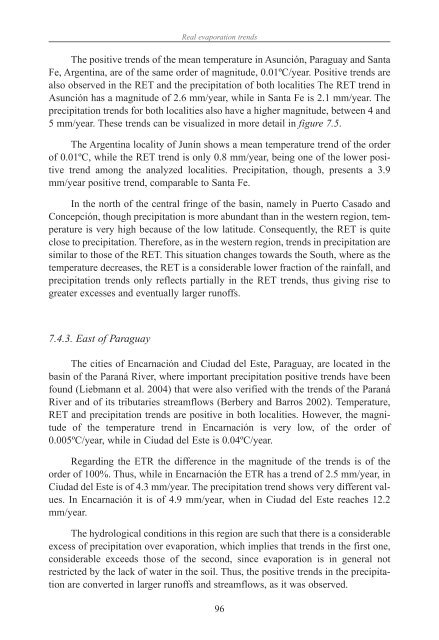chapter - Atmospheric and Oceanic Science
chapter - Atmospheric and Oceanic Science
chapter - Atmospheric and Oceanic Science
You also want an ePaper? Increase the reach of your titles
YUMPU automatically turns print PDFs into web optimized ePapers that Google loves.
The positive trends of the mean temperature in Asunción, Paraguay <strong>and</strong> Santa<br />
Fe, Argentina, are of the same order of magnitude, 0.01ºC/year. Positive trends are<br />
also observed in the RET <strong>and</strong> the precipitation of both localities The RET trend in<br />
Asunción has a magnitude of 2.6 mm/year, while in Santa Fe is 2.1 mm/year. The<br />
precipitation trends for both localities also have a higher magnitude, between 4 <strong>and</strong><br />
5 mm/year. These trends can be visualized in more detail in figure 7.5.<br />
The Argentina locality of Junín shows a mean temperature trend of the order<br />
of 0.01ºC, while the RET trend is only 0.8 mm/year, being one of the lower positive<br />
trend among the analyzed localities. Precipitation, though, presents a 3.9<br />
mm/year positive trend, comparable to Santa Fe.<br />
In the north of the central fringe of the basin, namely in Puerto Casado <strong>and</strong><br />
Concepción, though precipitation is more abundant than in the western region, temperature<br />
is very high because of the low latitude. Consequently, the RET is quite<br />
close to precipitation. Therefore, as in the western region, trends in precipitation are<br />
similar to those of the RET. This situation changes towards the South, where as the<br />
temperature decreases, the RET is a considerable lower fraction of the rainfall, <strong>and</strong><br />
precipitation trends only reflects partially in the RET trends, thus giving rise to<br />
greater excesses <strong>and</strong> eventually larger runoffs.<br />
7.4.3. East of Paraguay<br />
Real evaporation trends<br />
The cities of Encarnación <strong>and</strong> Ciudad del Este, Paraguay, are located in the<br />
basin of the Paraná River, where important precipitation positive trends have been<br />
found (Liebmann et al. 2004) that were also verified with the trends of the Paraná<br />
River <strong>and</strong> of its tributaries streamflows (Berbery <strong>and</strong> Barros 2002). Temperature,<br />
RET <strong>and</strong> precipitation trends are positive in both localities. However, the magnitude<br />
of the temperature trend in Encarnación is very low, of the order of<br />
0.005ºC/year, while in Ciudad del Este is 0.04ºC/year.<br />
Regarding the ETR the difference in the magnitude of the trends is of the<br />
order of 100%. Thus, while in Encarnación the ETR has a trend of 2.5 mm/year, in<br />
Ciudad del Este is of 4.3 mm/year. The precipitation trend shows very different values.<br />
In Encarnación it is of 4.9 mm/year, when in Ciudad del Este reaches 12.2<br />
mm/year.<br />
The hydrological conditions in this region are such that there is a considerable<br />
excess of precipitation over evaporation, which implies that trends in the first one,<br />
considerable exceeds those of the second, since evaporation is in general not<br />
restricted by the lack of water in the soil. Thus, the positive trends in the precipitation<br />
are converted in larger runoffs <strong>and</strong> streamflows, as it was observed.<br />
96






